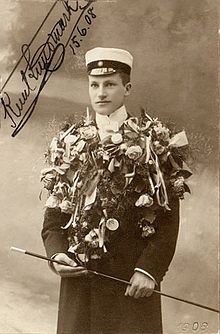Knut Lundmark
Knut Emil Lundmark ( pronunciation : [ ˌknʉːt ˈlɵnːdmaɹk ], born June 14, 1889 in Älvsbyn , Norrbotten County , † April 23, 1958 in Lund ) was a Swedish astronomer , and from 1929 to 1955 professor of astronomy and director of the Old Lund Observatory .
Lundmark studied astronomy at the Uppsala Observatory . His doctoral thesis, written in 1920, dealt with The relations of the globular clusters and spiral nebulae to the stellar system (the relationships between the globular clusters and the spiral nebulae to the star system, i.e. the Milky Way ). In the twenties he worked for a time at various observatories in the USA, the Lick Observatory and the Mount Wilson Observatory .
Knut Lundmark was one of the pioneers in the study of galaxies and their distances. He was one of the first to believe that galaxies are distant star systems and are comparable in size to the Milky Way .
He determined the distance of the Andromeda Nebula on the basis of the appearance of novae , the brightness of which he compared with the brightness of the novae of the Milky Way.
In the 1930s he was also active as a popular writer on astronomical subjects, and also took part in radio broadcasts. In 1954 he was one of the signatories of the document that eventually led to the creation of the European Southern Observatory (ESO) in 1962 .
The lunar crater Lundmark is named after him, as is the asteroid (1334) Lundmarka . The Wolf-Lundmark-Melotte galaxy is also named after him, after Max Wolf and Philibert Jacques Melotte .
Web links
- Literature by and about Knut Lundmark in the catalog of the German National Library
- Publications by K. Lundmark in the Astrophysics Data System
- Obituaries for K. Lundmark in the Astrophysics Data System
- Knut Lundmark at the Old Lund Observatory in 1937
- History of the Uppsala Observatory
- Astronomy in Sweden 1860-1940 (English)
- the redshift distance relationship of the galaxies
| personal data | |
|---|---|
| SURNAME | Lundmark, Knut |
| ALTERNATIVE NAMES | Lundmark, Knut Emil (full name) |
| BRIEF DESCRIPTION | Swedish astronomer |
| DATE OF BIRTH | June 14, 1889 |
| PLACE OF BIRTH | Älvsbyn , Norrbotten County |
| DATE OF DEATH | April 23, 1958 |
| Place of death | Lund , Sweden |
